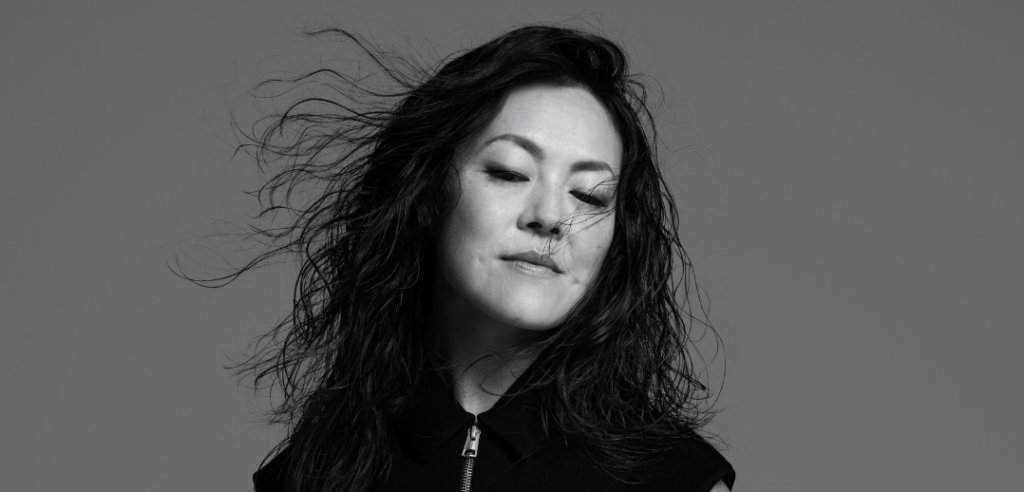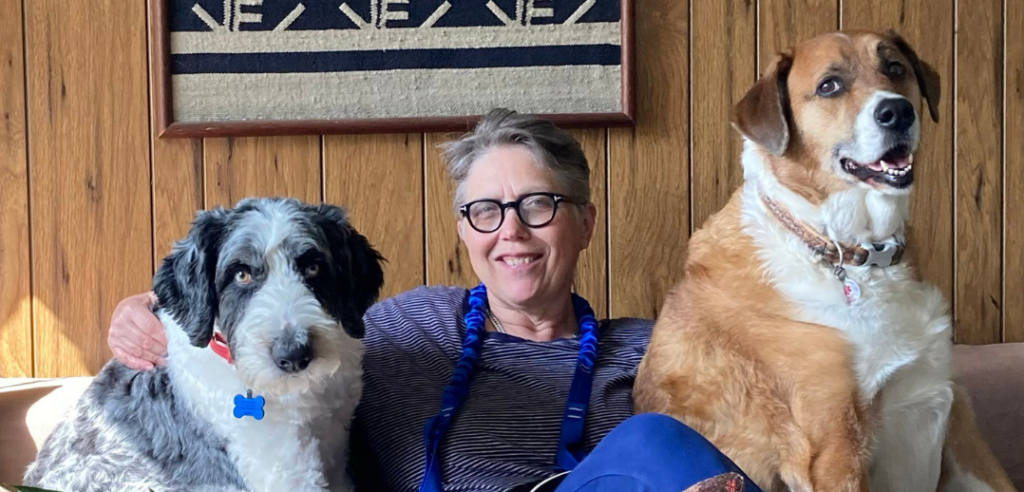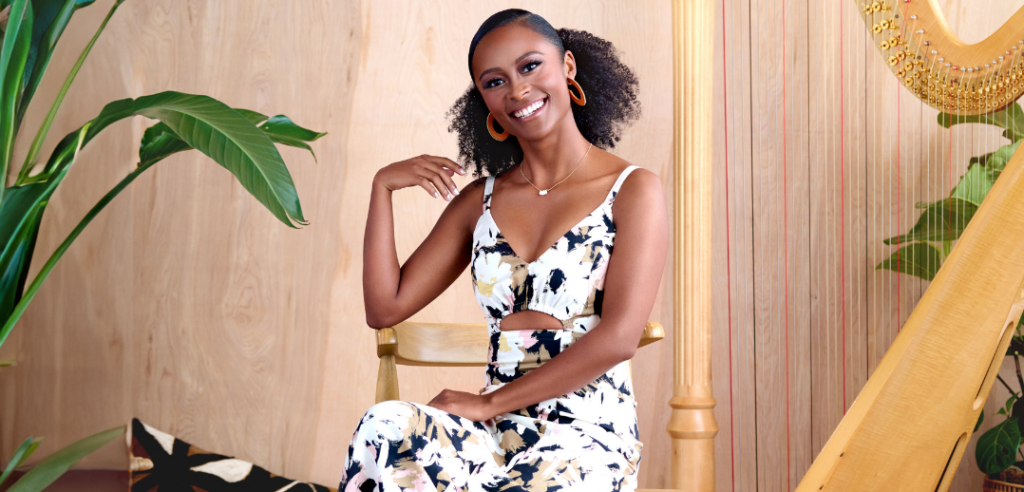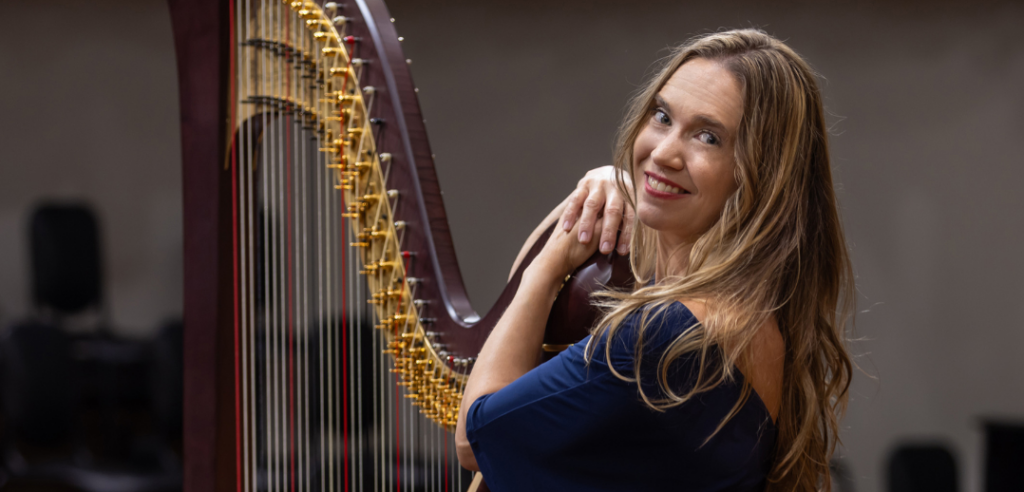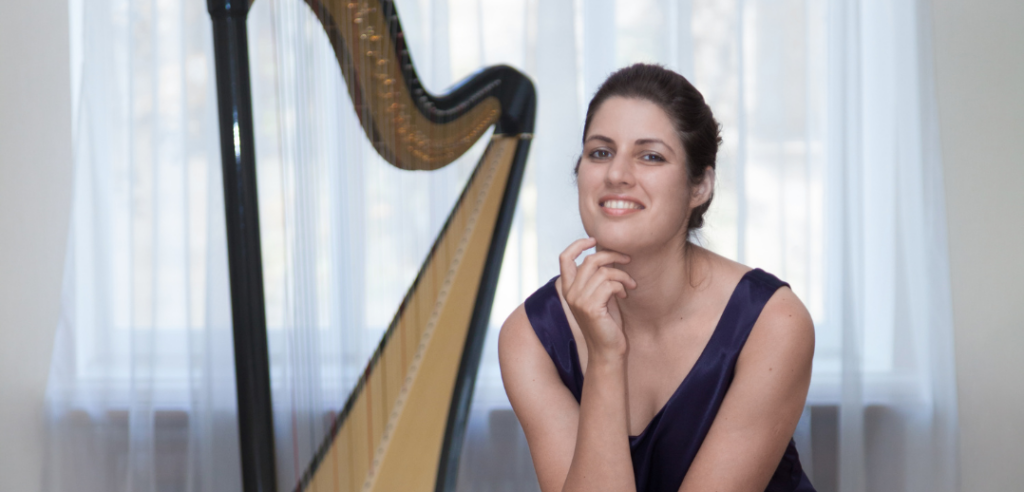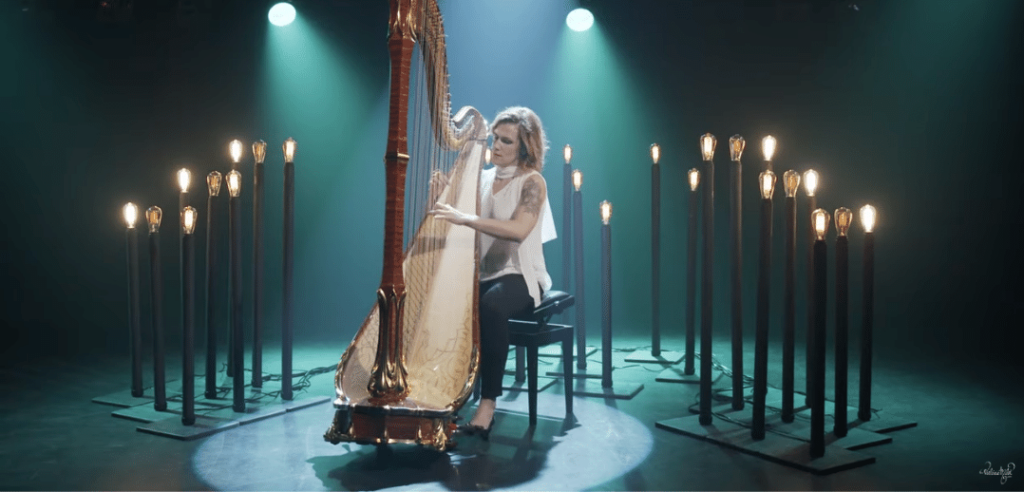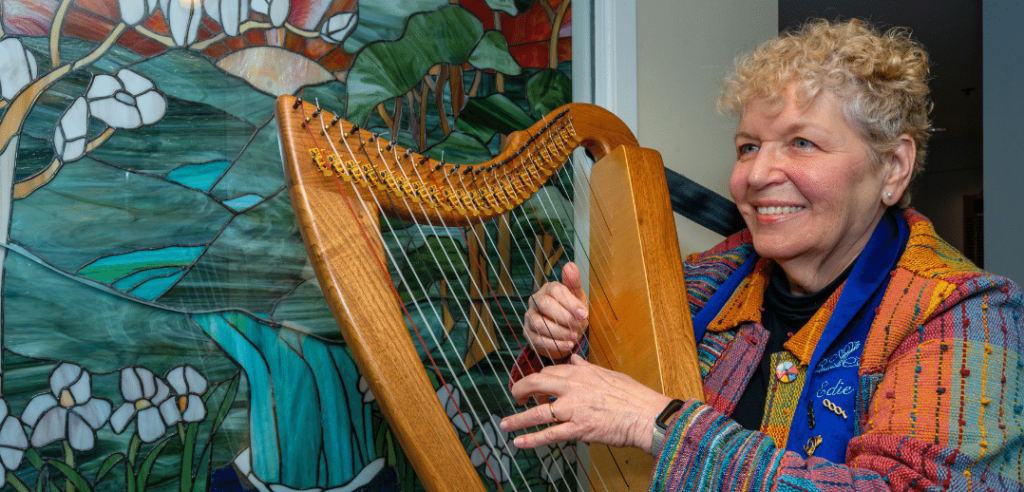
Meet Joris Beets. He solves harp problems. Beets didn’t like having to sit behind a big pedal harp on stage with other musicians. He wanted to be able to move freely with his instrument. So Beets, who is a designer by trade, created an instrument that would solve his mobility problem. Along the way, he managed to address a few other issues he had with the instrument he had fallen in love with as a kid, including sound projection, weight, and aesthetics. Beets named his creation the Delta harp (pictured here behind Beets on the wall).
But there are always more harp problems to solve. A few years after the Delta, Beets set out to tackle perhaps the modern harp’s biggest barrier to entry: cost. Until relatively recently in history, Beets points out, the harp was an instrument accessible to virtually anyone who could tie a few strings between a few sticks. Today, the harp has become an expensive instrument, with a reputation for being difficult to play. In order to “democratize” the harp, as Beets has said he wants to do, it would take much more than a low price tag. He had to untangle a web of interconnected challenges: minimizing cost while creating a harp that sounds beautiful, can be plugged in and amplified, is durable, can be stored in a compact case, and doesn’t require specialized training to fix when things break. Oh, and it needs to look cool too. But remember, Joris Beets solves harp problems. His answer to this puzzle is the Harp•E (the instrument Beets is holding in the photo on the facing page). We asked him about his newest creation and much more when he spoke with us from his London workshop.
Harp Column: When the Delta came out, and we talked to you about the design process, you said you started the process with the interaction between you and the harp. I thought that was interesting, because I would have thought you would start with sound or aesthetic. So tell us why you began the Delta design from the interaction.
Joris Beets: I guess because I designed the Delta, which in turn led to the Harp•E, while trying to play traditional harp in non-traditional settings and in different types of music. On stage or when touring, I found the instrument’s limitations, in large part, around the interaction. The harp is this unwieldy instrument, you can only sit behind it in one particular way, and it can’t really move. That’s why interaction was a logical starting point for me. But there is a larger web of design requirements floating in space of course. Like you say, the sound and aesthetics, but also the weight, practicalities, cost price and scalability. All of that needed to be condensed down together into a new design. But I would say interaction was a key thing to start with, especially when I started to see that if I developed and combined novel technologies in the right way, they could open up the interaction and enable an entirely new direction.
It can only be done if you have a love for the instrument, and you just go and do it.
Fast forward to now—we have the ultra-light carbon fiber Delta. You can jump around with it on a stage, changing the whole interaction because you are wearing it like a guitar. Or you can spin around with it if you’ve got a wireless connection, so you could dance with your harp. You can also sit down and then you are suddenly playing it like an acoustic guitar by campfires.There are lots of other types of interactions you can do with it.
In its broadest form, I think interaction also means the ways of playing and therefore also the things that you play. I end up playing differently depending on which position I hold the harp. I see this in other people that have a Delta or Harp•E as well. There’s this bridge [on the Delta] that evokes these bass-guitar-like things with your left hand, a rhythmic and repetitive way of playing with your left hand and tapping the strings and other things that your brain just wouldn’t be inclined to do if you set the harp upright. Then again, if you sit down and you look at the strings at yet another angle it gives you a new way of looking at the strings and seeing patterns where your hands are moving around the instrument. So yet again, you start to play different kinds of music. Fascinatingly, every instrument has some natural things that you start doing when you improvise. If your instrument allows for different positions and different ways of playing it, it also inspires more musical outcomes. It has been amazing to see how other people play the Delta over this last decade. And now with the Harp•E and its microtonal levers, for instance, people end up doing such different things—things that I’d never thought of myself.
HC: Were you surprised by how much the harp community embraced the Delta?
JB: No, I never see anything coming. I am very intuitive—I just go. Obviously there’s no business plan behind starting to design a harp, because it’s extremely difficult to do anything new in that space. It’s dominated by a few grand manufacturers, and harpists tend to look for very specific, traditional things [in a harp]. Also, if you manage to do anything, it’s such a small world that it’s not something you do with a grand business plan in mind. It can only be done if you have love for the instrument, and you just go and do it.
HC: When you first started working on this idea for the Delta, did you have an end result in mind?
JB: In an abstract form, there was definitely an end goal. In a specific form, there wasn’t. I had no idea what it was going to be, but I felt there was this gaping hole for a harp, or maybe not even a harp, but an instrument that you play like a harp with its beautiful sound and intimate feel, but much more versatile, accessible, and intuitive. For me, the harp is an ancient and natural extension of your body in the way you touch the strings and embrace the instrument. People who have never tried often expect it to be difficult, because we’ve allowed it to become such an exclusive and niche instrument. But a complete beginner can just touch a few strings, and immediately be transported into this beautiful universe of sound. It’s very different from starting to play, say, a violin. But there were these key things missing with the harp—it needed to be more versatile so you could play it in different ways and play different kinds of music, play different musical genres, and have a different type of mindset about the instrument. When I started playing the harp, there was a set way of doing it: this is your technique, these are the things we do on harps, you go from a lever harp to pedal harp, you can then choose to become either a teacher or play in an orchestra, and then you get a mortgage to buy a harp. There was very much a path that you started on if you were a young child. So I knew I wanted to design an instrument that would break free of that, probably something like a harp, or an instrument that has that kind of feeling a harp has. It’s quite an abstract thing to start to design.
HC: So this design project that ended up being the Delta harp was really driven by what you felt was missing from the instrument when you were young?
JB: You’re a kid exploring this magical instrument, and suddenly you see it narrowing, and I could see that the other students around me—they were all girls—so you start to notice at some age, apparently, that this is a female instrument. Then you start to notice that the music being played and performed starts to narrow. For me, it felt like a dead end. I didn’t feel like that was the way to go for me. And then when I got to my teenage years, of course, I found that it wasn’t that cool either. There was no way you could play in a band. It wasn’t like being on stage with a guitar. So I stopped playing the harp in my teenage years, and I started to play drums and percussion. That helped open up other types of music. When I was at university, I was playing as a percussionist in various bands, but I missed the harp. I tried to introduce my traditional old harp basically into these bands I was playing in, but I ran into its limitations, which I addressed with the design of the Delta: it has to be versatile; it has to open up new avenues for the instrument; it has to be cool. That way, when a harpist gets to a certain age, or if you don’t want to go into the classical world, you can use this other instrument and feel like you belong on a stage with other modern instruments or you belong in a band or fit into other types of music.
The first wooden Delta came about after trying lots of prototypes in bands. We experimented with new interactions in different playing positions. We also found the technology to pick up the sound properly. Instead of using individual pickups, which create lots of hassle, are very expensive, and lose the heavy bass sound, this new technology has a warm deep sound at the lower end, which is where I felt the beauty of the harp sits for me.
So there was not an end goal in mind, but it was kind of an amalgamation of all these thoughts. Looking at what the latest version of the Delta is, it is kind of strange to say it is kind of the end of the line for this. It looks beautiful. It sounds beautiful. It has the versatility I was looking for. It’s the right size. The wooden Delta was almost there, but it was still a bit heavy and inert in movements, making you worry about bumping into things. Whereas this carbon fiber version is even more compact by placing the strings in a smarter way, it’s half the weight and the tension distribution, look, feel and sound are just perfect, for me at least.
HC: You were really a disruptor in the field when you came out with the Delta, and then you ended up partnering with Salvi. How did that collaboration come about, and how has it worked?
JB: I was performing with the early prototypes in arts venues across Europe with lots of musicians in the audience and they would come up to me and say, “Wow, what’s that?” They were not usually harpists, which, to me, was very encouraging. I thought this meant the Delta would open up the instrument to other people that would otherwise not be interested in the harp. They would ask: “Where did you get that thing? Can you get me one?” I would tell them, “Well, I made this one. I can make you one if you want.” This way I made five and then 10 and 20. It soon became repetitive, and I’m very much an inventor, prototyper, innovator, and not someone who likes repetition. Every time I made one, it was better, and I figured out the intricacies of the product. But I also felt the limitations of my own patience and the fact that there are other people better at woodworking etcetera. This was all in the back of my mind, and at that point I just thought this thing needs to be in the world. I took it to the World Harp Congress in Sydney [in 2014], which was where I met Salvi. I was in the exhibit room, pushed away in a corner. It did feel like I got the cold shoulder quite a lot from the “established world order.” There were lots of comments like, “That’s not really a harp. It’s too loud. Turn down the volume.” But also, some people found it very refreshing. Probably at the time 10 percent loved it, and the rest were like, “What are you doing?”
Over the course of the week that started to change a bit. You could see that some people started to understand that this is actually quite interesting. Harpists of the younger generation were very interested and tried it out. It became busier and busier every day. It also helped that some of the bigger names in the field like Remy van Kesteren and a few others got it immediately. They were like, “Yes, this is the kind of thing that we’ve been waiting for.” They had won the prizes and played everything 1,000 times and were at the point where they were asking, “What’s next? What else can I do?” Something needed to change. I could definitely see, there was an appetite for it. Enzo, Salvi’s managing director, was there and he noticed that there was quite a crowd around my little booth tucked away in a corner. He saw there was something going on there. He circled my booth for a week. I noticed him standing from a distance. By the end of the week, he came up to me and said, “We need to talk.” Salvi was in a transitional period, looking for what’s next, what does the next century look like for harps, what is Salvi going to do next. So the timing was really good in that sense. They had to sort some stuff out in the factory, but it all fit together so beautifully, and their R&D team is just an amazing bunch of people—super friendly and collaborative. They are very good at certain things, but I think their strength is also that they know very well what they don’t know, too. By coming in there with this different angle, we were an exact match and had an amazing state of flow in our collaboration. It couldn’t have been smoother. It was a relief to have these guys that have this ancient craftsmanship in their fingers and know they can do every single detail of the harp to perfection so I could step away and focus on the innovation.
Once that was running, I developed a 49-string chromatic Delta, but that’s like a niche within a niche. So in terms of a market, there’s not much there. But it was an important design step to experiment with closer string spacing, larger forces, and different types of strings. So I went back to my shed and started experimenting with other materials. Carbon fiber is amazingly light and strong but also turned out to be an unexpectedly beautiful sounding material if you apply the right science and mixed compounds. When I brought [the carbon fiber design] to Salvi, it was easy to convince them because they knew that I could do new things at that point. We started looking at ways to do carbon fiber at scale. You need quite a different setup from woodworking. So we found this amazing race car manufacturer around the corner, in the same group of villages as where the Salvi factory is.
HC: You’re kidding.
JB: Yeah, they make carbon fiber frames for Formula One cars and aerospace, so there was synergy there. For a fairly complicated new technology, the design trajectory was fairly short. I think it only took maybe five prototypes, which is very few. It has worked beautifully.
HC: What feedback did you get from traditional harpists about the adjustment to the guitar-like playing position?
JB: It varies wildly. There’s definitely a large segment that is always a little bit cautious with anything new. It also seems like the more they’ve perfected their technique on one type of traditional harp, the harder it is to play anything else. They are usually nervous when they’re trying it out. The electric side of it is also very scary to some. But when they see someone else playing [the Delta] first, then they’re interested. The younger generation is definitely very interested in it. The early adopters usually have played different instruments, like the guitar and the piano, so their attitude is that the Delta is just a different instrument that I will have to adjust to a bit. It takes some people only five minutes and others many weeks before they get this different way of playing and expand their comfort zone.
HC: What is your design background?
JB: I’ve always been like a maker and a musician at the same time, they’re very similar things to me. My way of making music and my way of designing is almost the same. It’s listening, absorbing, analyzing, reflecting—it’s these iterative cycles of trying things out.
When playing music, I probe mistakes as interesting twists. You latch onto them and dive deeper into them, deconstructing and reconstructing. That’s also how I design things too, so to me they are very similar processes with different outputs. Whether it’s a piece of improvised music or an object that comes out [of the process], I’ve allowed something to come out that is surprising both to me and the audience or market. Something that pushes boundaries and has a clear purpose.
Music is an art form, but it’s also purposeful. The way I make music is very non-traditional—I was a very bad music student in the traditional system I grew up in. I still can’t read notes properly. They don’t convey the required context-dependent, fleeting, and spontaneous aspect [of the music] to me. I studied design and engineering in Delft, Holland, and I graduated on an unusual percussion instrument. I was one of very few students that had their graduation project mass produced. This was a good confidence boost to follow my instinct. In my professional life as an inventor, I’ve designed lots of products and services, often initially seen as quite unusual and different. Many of these eventually won design and innovation awards. [Ed.—The Delta harp received a Red Dot Design Award in 2017, and the Harp•E won the 2022-2023 A’Design Award.] It’s not why I do it, but it’s a nice recognition that if you invent with passion and intent to really address a problem or situation that you feel like changing, then eventually something will come out of it. And if it doesn’t happen that round, then you will gain all these insights that will then allow you to do a next iteration that will eventually get you there.
HC: You’ll get there, even if your path isn’t a straight line.
JB: Yes, like I was saying about being at the World Harp Congress for the first time with this new invention, it wasn’t easy, you get the cold shoulder, and many people don’t get what you’re doing. At first a small minority of people understand what it is that you’re trying to do. Then eventually, these harp ambassadors become the instigators of a movement. Ten years later, I’m at the World Harp Congress again. It was last summer [2022] in Cardiff. I went in with he latest invention—the Harp•E. I was expecting another cold shoulder, but the reception was so different. It was so warm. I did not expect that. I guess I underestimated how much the Delta had been appreciated since its release. I’m no longer this weirdo—I have more credibility.
HC: You are a known quantity now.
JB: It definitely was a very different experience. Also, 10 years later, there is almost an entirely new generation of students, management, and teachers. A lot has changed in the harp world. People tell me that the Delta played a role in giving them an alternative vision of what harp can be—it doesn’t have to be just classical. You see [classically trained harpists] Remy [van Kesteren] Sasha [Boldachev] playing both.
HC: It doesn’t have to be A or B, it can be A and B.
JB: Yes—you have options to keep going with this instrument with any type of music.
HC: We talked a little bit about what you were trying to do when you created the Delta. Did you have an end goal in mind with the Harp•E? What problems were you trying to solve?
JB: With the Delta, the only challenge left unaddressed was broad accessibility. It’s still produced in fairly low quantities compared to other instruments. It’s made in Italy by Salvi’s exceptional craftspeople. But that also means that they’re not cheap. “Expensive” is the wrong word because you get a super high-end instrument for the money, but it is still a large sum for a lot of people. Throughout history, harps have always been something ordinary people played by the campfire; penniless troubadours would travel the continent with them to tell their stories. We’ve lost that a bit, at least in the Western world. The harp has become a stationary, fragile, exclusive instrument that is perceived to be difficult because so few people play it. People only realize how intuitive it is when they have the opportunity to give it a try, and only realize all the other things you can do with it once they see an electric one being used in for instance a band. I discussed with Salvi for instance—how do we make an entry-level version of the Delta, but it was clear that if you want to have a good quality electric harp. It’s going to be very difficult to make it affordable unless you design for scale and redesign the very principle of the lever harp from the ground up. This didn’t fit their strategy at the time, so I went it alone, but they have been supportive along the way.
HC: Tell us how the Harp•E began.
JB: The original starting point was a question by a charity in Amsterdam, Het Leerorkest. It provides free music education to about 5,000 students from disadvantaged areas in urban environments in the Netherlands. They noticed that there was a high demand for harps—when given instruments to choose from at the start of the school year, a large proportion of children gravitate towards the harp because it’s intuitive and immediately sounds beautiful. They feel exactly the feeling that I had when I was a five year old and saw a harp for the first time—it was this immediate love. The strings go up to the sky, and you feel it vibrate, and you can hold it and pluck it, and there’s all these different sounds, and it’s such an amazing instrument. But this charity could only provide very few harps, and they would often break down halfway through the year and no one could fix it, because they’re made in some far away place, and they didn’t have money to have an engineer come fix it. In short, they had a harp problem. Remy [van Kesteren] heard this and said, “Wait a minute—I know someone who solves harp problems.” So he gave me a call and said, “You need to go and chat to Marco de Souza, because I think they’re looking for a solution to a harp problem you could probably solve.” The stars aligned. Marco, the charity’s founder, organized a crowdfunding campaign on Dutch national television that completed in no time. That kickstarted development and allowed us to go on this journey of interviewing harp teachers in schools, musicians, students, parents, maintenance engineers, etc. We developed this long list of requirements that we would ideally meet. It had to be sturdy, easy to stow away, stackable, unaffected by humidity, and all that kind of stuff. Of course, all the teachers wanted all the levers and all the strings, so we had to understand from them what the optimal minimum range of strings is you need for the first several years of education in school to be able to play all the pieces. The other main cost driver are the levers—because good quality levers are intricate little mechanisms with about 10 metal parts per lever. So the big engineering breakthrough was this new mechanism that replaces all these metal parts with just two and replaces all these individual mechanisms with just one integrated mechanism. Suddenly, the lever cost issue was solved, as well as the cost over time, because the new mechanism can be self-regulated, no need for engineers for those faraway places ever again.
HC: What did you do to make the instrument more durable and test the durability? Anybody who’s been in a school situation knows how the wear and tear on those instruments adds up.
JB: That was exactly the comment that we got from many of the teachers we talked to. Durability was definitely very, very high on the agenda. We tested the prototypes with children. It’s nerve-racking to watch a bunch of six-year-olds with your prototypes, as you can imagine, but we got there. One of the main design challenges was designing it so that if it falls over, it doesn’t break. There are so many technical details, I won’t bore you with those, but the redesigned mechanism fundamentally changed the whole construction of the harp. When you’re working on a design project, at some point you have this moment where you seem stuck. But then you find this strange little back alley where suddenly there’s a solution, and it makes all the other things not feel like a waste of time because you’ve already explored all of these dead ends and somehow there’s a little door that connects all of them so everything works. In this case, that little door was the mechanism. By having a mechanism where the strings sit in the middle of the harp, the forces are no longer trying to bend the harp sideways. This means you can use a lot less material to make the harp structurally sound, and you can make it completely symmetrical so it’s very solid and strong. We created a sort of exoskeleton where the mechanism and any fragile parts sit sandwiched between two frame halves. You can just drop the thing on the floor because [the frame] itself is like a flight case. The levers and all other wooden parts are cut out of the same basic beech multiplex plywood sheet that the two frame halves are cut out of, so it’s like a jigsaw with extremely little wood waste. And when you put the harp into its fabric carrier bag, it all fits back into itself, and you can pile dozens on top of each other, like you would never imagine to be able to do with harps.
HC: Right, because you don’t have to protect the mechanism on one side of the harp.
JB: Yes, you can just lay them flat and stack them.
HC: When I see how the DIY version is packaged for shipping, it looks to me like something you would put together with an Allen wrench on the floor of your living room. Anyone who has put together a self-assembly piece of furniture knows it is never as easy as it looks. So, really, how long does it take for a harpist to put together a Harp•E themselves?
JB: There are three packages. The original version is complete DIY for the charity, so we could leave them with a bulk components pile for 300 harps. We then trained volunteers to assemble them, this kept the price absolutely rock bottom. We learned a lot from that process. We originally didn’t intend to sell them to individuals, but because of the crowdfunding campaign we got a lot of questions from individuals wanting to buy them.
HC: So you really had no plan to sell these beyond the charity?
JB: Well, like I said, I don’t plan that far ahead. I just wanted this thing to exist for them and then see. Once we had the assembly manual and videos done at a high level, it was actually a piece of cake for people to [assemble them]. So your question, how much time does it take, really? We do find that it takes a very varying amount of time for different types of people.
HC: Of course.
JB: So we developed the other two packages. There’s the Plug & Play, which is completely pre-assembled, pre-strung, pre-regulated, and ready to go. Even in that premium format the price is only a fraction of comparable electric harps. Then to make it accessible to even more people, there’s the String & Go package, basically the same price as DIY but we have pre-assembled it. So you only need to do the stringing and tuning, familiar things to many.
HC: Compared to assembling a self-assembly dresser or rocking chair, how difficult is the DIY package? I’ve been pretty frustrated by those.
JB: The DIY package is for enthusiasts. I love it and there is a very active community around it now that exchanges tips, hacks, and mods. It’s what harpists have done throughout much of history, making their own instruments. So Harp•E offers this experience. You can even assemble it completely mirrored as a left-handed harp, or combine a left- and right-handed one into a double-strung. People have done that already, others have integrated MIDI components and can trigger lights and all kinds of stuff—yet another way it’s so accessible.
Individuals buying our harps help us as well to do more social impact projects where we work with charities, schools, and education at rock-bottom prices. We’re also working on developing teaching methods for electric harp for general music teachers. How long does it really take to build one? For the String & Go, it’s pretty much the same as putting new strings on any harp. The good thing about this particular design is that it’s a very stable triangle. The strings are silk gut strings, which are known to be very stable. And easy to work with. The quickest I’ve seen a harp settle is about a week and the slowest have settled in about three weeks. You tune it once or twice a day until it’s stable. And then, like I said, you can regulate the mechanisms yourself with that little Allen key.
HC: All you need is an Allen wrench and anything is possible.
JB: For the self assembly, it takes us about half an hour to assemble the parts. If you’re doing it for the first time, and you don’t have any tools, it will take more like an hour or two. There are definitely people that would take three hours. And then you can string it.
HC: So for the complete self-assembly, it only takes a few hours?
JB: Yeah, just a few hours.
HC: That’s still less than I would have thought.
JB: If you have an electric screwdriver, that definitely speeds things up. But in principle, all you need is the Allen key that comes with the package. That’s also the tuning key. There’s no more need for buying crazy expensive tuning keys.
HC: What has been your favorite part of the process in developing the Harp•E?
JB: I love every single bit of it.The eureka moment was when this mechanism worked. The second highlight was the feeling when I saw new young harpists playing version one the first time on stage at the Dutch Harp Festival. I can’t describe that feeling other than…it’s like when you see your child walk for the first time.
HC: So you’re based in London now—is that where the Harp•E is being produced?
JB: I am based between London and Holland. My design studio is in London, our build studio is in Utrecht, Holland. We have an amazing team of enthusiasts doing the assembly and coaching and dealing with all the questions that come in.
HC: Do you see a future where you partner with a more traditional harp maker or to scale up production, or do you see yourself sticking with what has worked so far?
JB: Initially I considered that—it’s always a fast-track way of doing things. But to stay lean and keep the cost to an absolute minimum, we decided to do everything ourselves.
HC: How would you describe the journey you’ve been on to creat the Harp•E?
JB: When I step back with perspective, it’s been an incredibly positive experience. It has definitely had its challenges, through a pandemic and war in Europe just as we were starting. The saying “what doesn’t kill you makes you stronger” very much applies. Today our Ukrainian wood is mostly available again and supply chains have somewhat settled. But because of the past volatility, we had to find alternative routes for everything. We had to have a very nimble design that we could easily adapt when parts suddenly would not be available anymore or skyrocketed in price. Now we have a very flexible company and structure and supply chain and product, which I think is really ready for scaling.
Now music teachers who are themselves not harpists are contacting us because they want this harp. It’s affordable and also electric so you can plug it in. And it uses the other things that they’re teaching in schools like working with the software programs and composing. They see this as an instrument that they can incorporate into the normal repertoire of instruments. So now we’re starting to partner with people who can develop methods for teachers who are not necessarily harpists who can then teach children and integrate the harp into music lessons. That’s, of course, the holy grail if suddenly, the harp is a ubiquitous instrument that it once was in history, instead of this exclusive instrument it has become. It’s now something someone can just pick up and try.
HC: It’s no longer the rare instrument that nobody knows or understands.
JB: And the interesting thing in talking to Salvi is that they understand that, even if we perhaps end up in slight competition, if we can make the harp more accessible, and get more people to play, it helps everyone. If only one percent of the people that play guitar now start playing harp, you’ve opened up the harp market. If even one percent of those people start playing the concert grand harp, we’ve multiplied their business too.
HC: A rising tide raises all ships.
JB: It’s good for everyone. And [Salvi] is just a bunch of nice guys. They really care about harps and believe the instrument should be more widely available.
HC: What’s next for you?
JB: There are so many things that are opening up. With all the questions and suggestions from the community, we can build a whole ecosystem on the service side, electronics side, and educational side. There are some amazing artists and organizations that want to collaborate. It feels like we’re just getting started on a Harp•E journey.









